
The South Manchuria Railway, officially The South Manchuria Railway Company, Ltd., or 滿鐵 for short, was a large National Policy Company of the Empire of Japan whose primary function was the operation of railways on the Dalian–Fengtian (Mukden)–Changchun corridor in northeastern China, as well as on several branch lines.

A streamliner is a vehicle incorporating streamlining in a shape providing reduced air resistance. The term is applied to high-speed railway trainsets of the 1930s to 1950s, and to their successor "bullet trains". Less commonly, the term is applied to fully faired recumbent bicycles. As part of the Streamline Moderne trend, the term was applied to passenger cars, trucks, and other types of light-, medium-, or heavy-duty vehicles, but now vehicle streamlining is so prevalent that it is not an outstanding characteristic. In land speed racing, it is a term applied to the long, slender, custom built, high-speed vehicles with enclosed wheels.

The Asia Express was an express passenger train operated by the South Manchuria Railway (Mantetsu) from 1934 until 1943. This limited express, which began operation in November 1934 and was Mantetsu's most iconic train, operated in Manchukuo between Dalian and Xinjing, and was extended to Harbin in 1935.
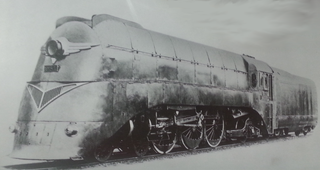
The China Railways SL7 class steam locomotive was a class of 4-6-2 express passenger steam locomotives operated by the China Railway. They were originally built for the South Manchuria Railway (Mantetsu) to pull the Asia Express - Mantetsu's signature train and most iconic locomotive, whose images were used on fliers, posters, postage stamps, and even children's school textbooks, as a symbol of technology and modernism in Manchukuo and was used to demonstrate the success of Japan's imperial project.
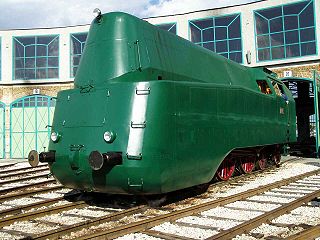
MÁV Class 242 was a 4-4-4T steam locomotive of Hungarian State Railways. A small class of only four examples, they were built between 1936 and 1939. They were highly unusual in that they were both streamlined, as was the fashion of that period for fast express service, but they were also tank locomotives.

The China Railways JF6 class steam locomotive was a class of 2-8-2 steam locomotives for freight trains operated by the China Railway. They were originally built in Japan and Manchukuo between 1934 and 1944 for the South Manchuria Railway (Mantetsu), the Manchukuo National Railway, and the North China Transportation Company.

The China Railways SL6 class steam locomotive was a class of 4-6-2 superheated two-cylinder passenger steam locomotives operated by the China Railway. Originally built for the South Manchuria Railway (Mantetsu), the Manchukuo National Railway, the Central China Railway and the North China Transportation Company by several Japanese manufacturers between 1934 and 1940, they were the most numerous class of steam passenger locomotive in China, with 422 eventually built.

The China Railways SL11 class steam locomotive was a class of 4-6-2 passenger steam locomotives operated by the China Railway. They were originally built for the South Manchuria Railway and the Manchukuo National Railway by ALCO of the United States in 1908, and have the distinction of being part of the first group of standard gauge locomotives to operate in northeastern China.
The China Railways SL2 class steam locomotive was a class of 4-6-2 passenger steam locomotives operated by the China Railway. They were originally built for the South Manchuria Railway (Mantetsu), where they were designated Pashini (パシニ) class.

The China Railways SL3 class steam locomotive was a class of 4-6-2 passenger steam locomotives operated by the China Railway. They were originally built for the South Manchuria Railway, the Manchukuo National Railway and the North China Transportation Company by several Japanese manufacturers between 1934 and 1940. They were designed in 1933 based on the design of the first Pashisa class locomotives ; the first order was placed by Mantetsu in March of that year.
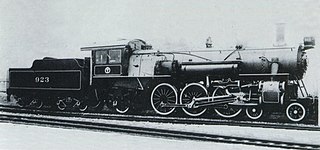
The China Railways SL4 class steam locomotive was a class of 4-6-2 passenger steam locomotives operated by the China Railway. They were originally built for South Manchuria Railway (Mantetsu), where they were designated Pashishi (パシニ) class. Mantetsu's 1938 "Pashishi" classification was made up of two distinct classes of locomotive, the former G2 and G3 classes, built in 1919 and 1921 respectively, for Mantetsu and for the Manchukuo National Railway.
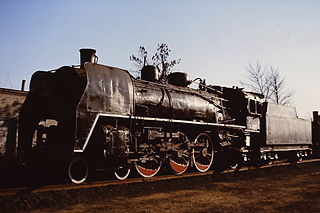
The China Railways SL5 steam locomotive was a class of 4-6-2 passenger steam locomotives operated by the China Railway. They were originally built for the South Manchuria Railway in 1927 and 1928.

The China Railways SL8 class steam locomotive was a class of 4-6-2 express passenger steam locomotives operated by the China Railway. They were originally built for the South Manchuria Railway (Mantetsu) and the Manchukuo National Railway between 1937 and 1940.

The China Railways AM1 class locomotives were a class of 4-4-0 passenger steam locomotives operated by the China Railway, originally built for the South Manchuria Railway (Mantetsu). The "Ame" name came from the American naming system for steam locomotives, under which locomotives with 4-4-0 wheel arrangement were called "American".
The China Railways TH10 class steam locomotive was a class of 4-6-0 passenger steam locomotives operated by the China Railway. Originally amongst the first locomotives ordered by the South Manchuria Railway (Mantetsu), they were later operated by the privately owned Jichang Jidun Railway and its successor, the Manchukuo National Railway, which designated them Tehoni class. The "Teho" name came from the American naming system for steam locomotives, under which locomotives with 4-6-0 wheel arrangement were called "Ten-Wheeler".

The China Railways TH1 class steam locomotive was a class of 4-6-0 passenger steam locomotives operated by the China Railway. Originally built for the South Manchuria Railway (Mantetsu), some were also operated by the Manchukuo National Railway. The "Teho" name came from the American naming system for steam locomotives, under which locomotives with 4-6-0 wheel arrangement were called "Ten-Wheeler".
The Manchukuo National Railway Tehosa class steam locomotives were a class of 4-6-0 passenger steam locomotives operated by the Manchukuo National Railway. Originally built for the South Manchuria Railway (Mantetsu), they later transferred to the MNR. The "Teho" name came from the American naming system for steam locomotives, under which locomotives with 4-6-0 wheel arrangement were called "Ten-Wheeler".
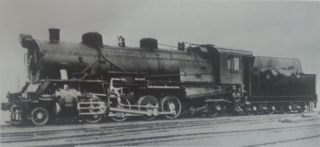
The China Railways JF2 class steam locomotive was a class of 2-8-2 steam locomotives for goods trains operated by the China Railway. They were originally built for the South Manchuria Railway (Mantetsu) by several American and Japanese manufacturers, as well as by Mantetsu's Shahekou Works, between 1924 and 1932.
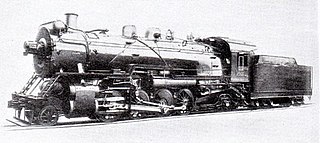
−

The China Railways MT1 class steam locomotive was a class of 4-8-2 steam locomotives for goods trains operated by the China Railway. They were originally built for the South Manchuria Railway (Mantetsu) in Japan in 1936. The "Mate" name came from the American naming system for steam locomotives, under which locomotives with 4-8-2 wheel arrangement were called "Mountain".


















